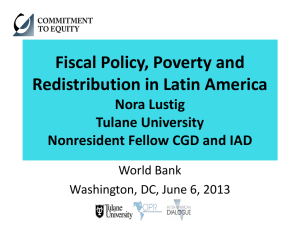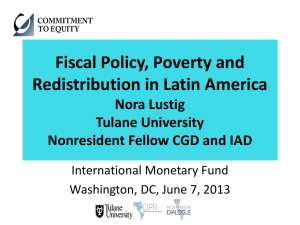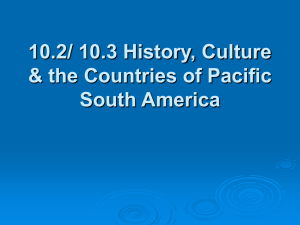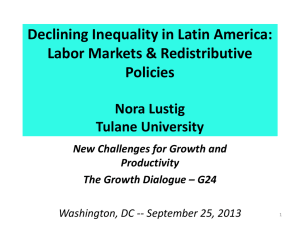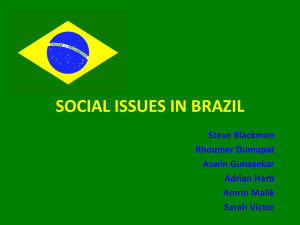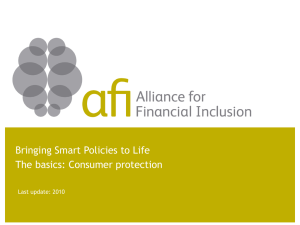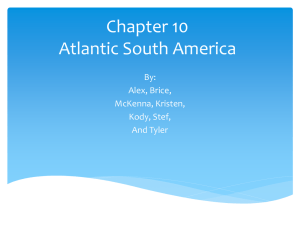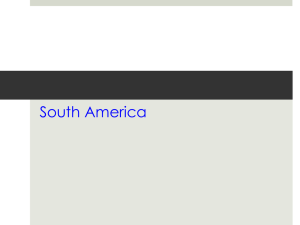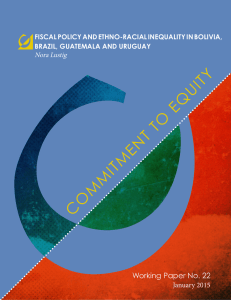Nora Lustig Tulane University CGD and IAD
advertisement
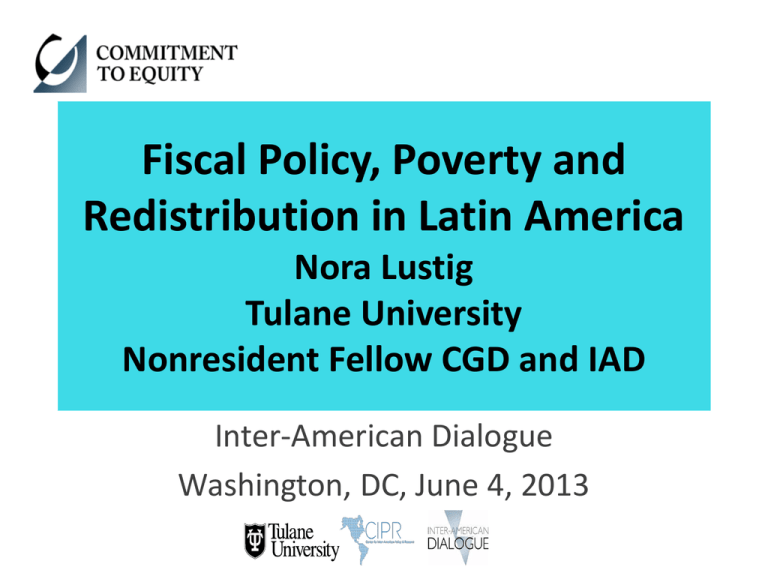
Fiscal Policy, Poverty and Redistribution in Latin America Nora Lustig Tulane University Nonresident Fellow CGD and IAD Inter-American Dialogue Washington, DC, June 4, 2013 LATAM IS THE MOST UNEQUAL REGION IN THE WORLD Gini Coefficient by Region (in %), 2004 (Ferreira and Ravallion, 2008) 60.0 55.0 53.2 Gini coefficient 50.0 44.7 45.0 40.0 35.0 32.2 38.9 38.9 39.1 South Asia North Africa and the Middle East East Asia and the Pacific 33.6 30.0 25.0 20.0 High Incom e Europe and Central Asia Sub-Saharan Latin Am erica Africa and the Caribbean 2 Declining income inequality by country: 2000-2010 (Annual average change in Gini in %) Poverty: 1992-2010 (Headcount Ratio in %) 50.0 44.4 45.0 41.5 40.7 40.0 35.0 30.0 29.6 27.8 24.7 25.0 24.9 20.0 16.3 15.0 10.0 5.0 0.0 1992 1998 $2.5 a day poverty line c.2000 $4 a day poverty line c.2010 • Why has inequality declined? –Declining inequality of hourly labor income –Larger and more progressive transfers –Lower dependency ratios 5 6 www.commitmentoequity.org 7 • Special issue: Lustig, Pessino and Scott. Editors. “Fiscal Policy, Poverty and Redistribution in Latin America,”Public Finance Review (forthcoming) – Argentina: Nora Lustig and Carola Pessino – Bolivia: George Gray Molina, Wilson Jimenez, Veronica Paz and Ernesto Yañez – Brazil: Sean Higgins and Claudiney Pereira – Mexico: John Scott – Peru: Miguel Jaramillo – Uruguay: Marisa Bucheli, Nora Lustig, Maximo Rossi and Florencia Amabile 8 Standard Fiscal Incidence Analysis • Pre-tax and benefits incomes • Allocators of taxes and benefits – personal income and consumption taxes – social spending: cash transfers and in-kind transfers (education and health) – Consumption subsidies • Post-tax and benefits incomes • Countries (yr of Survey): Argentina (2009), Bolivia (2007), Brazil (2009), Guatemala (2009), Mexico (2008), Peru (2009), Uruguay (2009), Paraguay (2010) 9 10 Results • Wide variation among countries in: – policy choices (or outcomes of political processes?) –impact of those choices on income redistribution and poverty reduction 11 Government size varies greatly in Latin America • Government spending is around 40 percent of GDP in Argentina and Brazil—similar to that of some European nations with larger welfare states • …while it is only around 20 percent in Mexico and Peru 12 Budget Size and Composition Primary and Social Spending as % of GDP 13 Redistributive Impact Heterogeneous • Taxes and transfers reduce inequality by nontrivial amounts in Argentina, Brazil, and Uruguay, less so in Mexico, and relatively little in Bolivia and Peru • Bolivia and Uruguay start from similar Market Income Gini’s but end in different places with Final Income • Brazil has the highest Market Income Gini by several orders of magnitude but ends up with a lower Final Income Gini than Bolivia and Peru 14 Gini Before and After Taxes, Transfers, Subsidies and Free Government Services 0.574 0.55 0.5 0.504 0.503 0.511 0.492 Argen na Gini 0.489 Bolivia 0.463 0.446 0.45 0.438 0.429 Brazil Mexico Peru Uruguay 0.4 0.393 0.369 Final Income Market Income 0.35 15 Direct Taxes Progressive but Underutilized • Personal income tax varies from around five percent of GDP in Uruguay to nearly zero in Bolivia • In all countries in which they exist, direct taxes are progressive, but because direct taxes are a small percentage of GDP almost everywhere, their redistributive impact is small 16 Gini Before and After Direct Taxes 0.574 0.563 0.55 0.511 0.492 Gini 0.5 0.504 0.503 0.503 0.498 0.497 0.478 0.45 Bolivia 0.463 0.438 0.446 0.429 Brazil Mexico Peru Uruguay 0.4 Final Income Net Market Income 0.35 Market Income 0.393 17 Cash Transfers Powerful Poverty-Reducing Mechanism only when Targeted and of Significant Magnitude • Cash transfers reduce extreme poverty by more than 60 percent in Uruguay and Argentina… ….but only by 7 percent in Peru, which spends too little on cash transfers 18 Headcount: Before and After Cash Transfers 25.00% 20.00% Argen na 15.00% Bolivia Brazil Mexico 10.00% Peru Uruguay 5.00% 0.00% Net Market Income Disposable Income 19 • Bolivia spends five times more in cash transfers than Peru (as a share of GDP) but… …because funds are not targeted to the poor, the amount of redistribution and poverty reduction has been limited: it is only slightly higher than in Peru 20 • Peru’s Juntos, although quite effective because of its fine targeting, achieves very limited poverty and inequality reduction because the scale of the program is small: –coverage of extreme poor is below 60 percent and per capita transfer is low (compared to poverty gap) 21 Coverage of Direct Cash Transfers 100.0% 90.0% 93.3% 87.7% 83.2% 80.0% 67.8% 70.0% 73.1% 57.7% 60.0% Poor<2.5 50.0% 41.9% 40.0% 2.5<=Poor<4 Non poor 29.2% 30.0% 20.0% 15.5% 10.0% 0.0% Bolivia Brazil Peru 22 “Leakages” of Direct Cash Transfers (Percent going to poor and nonpoor) 100% 90% 29.1% 80% 70% 62.0% 73.5% 60% 24.0% Non poor 50% 2.5<=Poor<4 Poor<2.5 40% 30% 12.8% 9.7% 20% 10% 46.9% 25.2% 16.8% 0% Bolivia Brazil Peru 23 Indirect Taxes and Poverty • In Brazil and Bolivia, indirect taxes wipe out most of the effect of direct transfers, and poverty is almost the same after as before taxes and cash transfers. • In contrast, in Mexico, indirect taxes and subsidies reduce poverty further, because exemptions and informality allow the poor to pay little in the form of indirect taxe 24 Headcount Ratio Before and After Indirect Taxes 25.00% 20.00% Bolivia 15.00% Brazil Mexico 10.00% Peru Uruguay 5.00% 0.00% Net Market Income Disposable Income Post Fiscal Gini Before and After Government Services Valued at Cost 0.55 0.5 0.563 0.543 0.498 0.503 0.497 Gini 0.489 0.493 0.494 0.478 0.488 0.447 0.45 0.457 Argen na 0.463 Bolivia 0.446 0.438 0.429 Brazil Mexico Peru Uruguay 0.4 0.393 Final Income Disposable Income 0.35 Net Market Income 0.369 26 Argen na-Reduc on in Inequality: Market (blue) vs. Redistribu on (red) 43% Redistribu on 124% 58% Market -24% 2003-06 2006-09 27 Argen na-Reduc on in Poverty: Market (blue) vs. Redistribu on (red) 88% Redistribu on 110% Market 12% -10% 2003-06 2006-09 28 Fiscal Incidence Indicators: Winners and Losers Who bears the burden of taxes and receives the benefits from cash transfers? • Fiscal incidence by decile and socio-economic groups 29 Incidence of Taxes and Cash Transfers Net Change in Income after Direct and Indirect Taxes and Transfers by Decile 20% 15% 10% 5% Bolivia Brazil 0% Mexico 1 -5% 2 3 4 5 6 7 8 9 10 Peru Uruguay -10% -15% -20% 30 Fiscal Incidence of Income, Taxes and Transfers, by Socioeconomic Groups Market Income Population Shares PostFiscal Income BOLIVIA (2009) Poor (<$4) Vulnerable ($4-$10) Middle Class ($10-$50) Rich (>$50) Total population MEXICO (2008) 29.1% 38.8% 30.8% 1.3% 100.0% 4.0% -1.5% -1.9% -1.2% -1.4% BRAZIL (2009) Poor (<$4) Vulnerable ($4-$10) Middle Class ($10-$50) Rich (>$50) Total population Market Income Population Post-Fiscal Shares Income Poor (<$4) 23.8% Vulnerable ($4-$10) 38.0% Middle Class ($10-$50)35.3% Rich (>$50) 2.9% Total population 100.0% 12.3% -0.1% -8.3% -9.8% -6.1% PERU (2009) 26.7% 33.5% 35.3% 4.5% 100.0% 15.1% -7.1% -14.0% -20.7% -13.7% Poor (<$4) 28.6% Vulnerable ($4-$10) 37.5% Middle Class ($10-$50)32.0% Rich (>$50) 2.0% Total population 100.0% 3.4% -2.5% -9.9% -17.8% -8.5% 31 In sum: Bolivia, Mexico and Peru • Although Bolivia spends five times more than Peru in cash transfers, because they are not really targeted to the poor they achieve little in terms of poverty reduction • In contrast, Peru’s cash transfers are very welltargeted but the size of the flagship program is small • In Mexico, the limitation is similar to Peru’s but less markedly so 32 In sum: Brazil The largely positive redistributive picture of Brazil has three main problems: • A substantial portion of cash transfers benefit the nonpoor • Indirect taxes weigh heavily on the market income poor and wipe out the redistributive and poverty reducing effect of cash transfers • About 16 percent of Brazilian social spending in tertiary education goes to the richest five percent of the population with incomes above US$50 per day. 33 In sum: Argentina • Poverty reduction and redistribution through fiscal policy are the highest in Argentina. Is Argentina a model of redistributive policies? – Increasingly relied on redistribution through cash transfers => pension moratorium – Pension moratorium: good for elderly women bad for incentives (informality) and problems of unfairness – Fiscal sustainability called into question: source of revenues such as inflation tax and international reserves are problematic 34 THANK YOU 35 Led by Nora Lustig (Tulane University) and Peter Hakim (InterAmerican Dialogue), the Commitment to Equity (CEQ) project is designed to analyze the impact of taxes and social spending on inequality and poverty, and to provide a roadmap for governments, multilateral institutions, and nongovernmental organizations in their efforts to build more equitable societies. CEQ/Latin America is a joint project of the Inter-American Dialogue (IAD) and Tulane University’s Center for Inter-American Policy and Research (CIPR) and Department of Economics. The project has received financial support from the Canadian International Development Agency (CIDA), the Development Bank of Latin America (CAF), the General Electric Foundation, the Inter-American Development Bank (IADB), the International Fund for Agricultural Development (IFAD), the Norwegian Ministry of Foreign Affairs, the United Nations Development Programme’s Regional Bureau for Latin America and the Caribbean (UNDP/RBLAC), and the World Bank. http://commitmenttoequity.org CEQ WORKING PAPER SERIES http://www.commitmentoequity.org “Commitment to Equity Assessment (CEQ): Estimating the Incidence of Social Spending, Subsidies and Taxes. Handbook,” by Nora Lustig and Sean Higgins, CEQ Working Paper No. 1, July 2011; revised January 2013. “Commitment to Equity: Diagnostic Questionnaire,” by Nora Lustig, CEQ Working Paper No. 2, 2010; revised August 2012. “The Impact of Taxes and Social Spending on Inequality and Poverty in Argentina, Bolivia,Brazil, Mexico and Peru: A Synthesis of Results,” by Nora Lustig, George Gray Molina, Sean Higgins, Miguel Jaramillo, Wilson Jiménez, Veronica Paz, Claudiney Pereira, Carola Pessino, John Scott, and Ernesto Yañez, CEQ Working Paper No. 3, August 2012. “Fiscal Incidence, Fiscal Mobility and the Poor: A New Approach,” by Nora Lustig and Sean Higgins, CEQ Working Paper No. 4, September 2012. “Social Spending and Income Redistribution in Argentina in the 2000s: the Rising Role of Noncontributory Pensions,” by Nora Lustig and Carola Pessino, CEQ Working Paper No. 5, January 2013. “Explaining Low Redistributive Impact in Bolivia,” by Verónica Paz Arauco, George Gray Molina, Wilson Jiménez Pozo, and Ernesto Yáñez Aguilar, CEQ Working Paper No. 6, January 2013. “The Effects of Brazil’s High Taxation and Social Spending on the Distribution of Household Income,” by Sean Higgins and Claudiney Pereira, CEQ Working Paper No.7, January 2013. “Redistributive Impact and Efficiency of Mexico’s Fiscal System,” by John Scott, CEQ Working Paper No. 8, January 2013. “The Incidence of Social Spending and Taxes in Peru,” by Miguel Jaramillo Baanante, CEQ Working Paper No. 9, January 2013. “Social Spending, Taxes, and Income Redistribution in Uruguay,” by Marisa Bucheli, Nora Lustig, Máximo Rossi and Florencia Amábile, CEQ Working Paper No. 10, January 2013. “Social Spending, Taxes and Income Redistribution in Paraguay,” Sean Higgins, Nora Lustig, Julio Ramirez, Billy Swanson, CEQ Working Paper No. 11, February 2013. “High Incomes and Personal Taxation in a Developing Economy: Colombia 1993-2010,” by Facundo Alvaredo and Juliana Londoño Vélez, CEQ Working Paper No. 12, March 2013. “The Impact of Taxes and Social Spending on Inequality and Poverty in Argentina, Bolivia, Brazil, Mexico, Peru and Uruguay: An Overview,” Nora Lustig, Carola Pessino and John Scott, CEQ Working Paper No. 13, April 2013. 37
